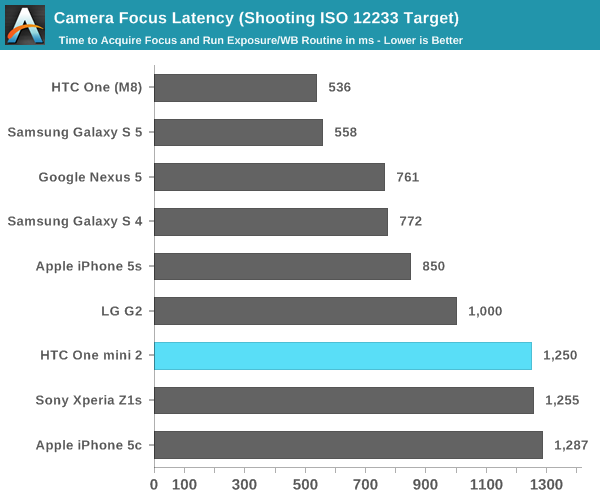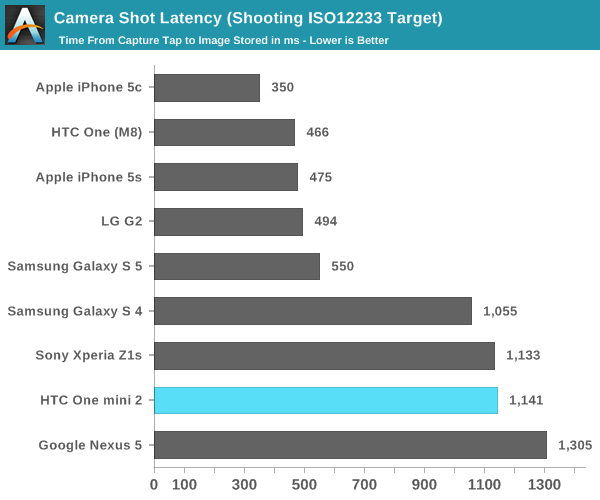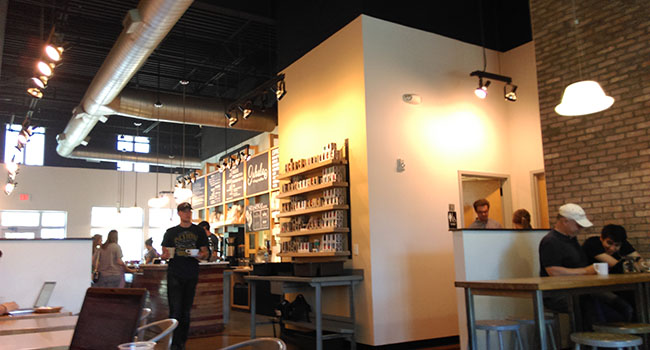HTC One mini 2 Review
by Anand Lal Shimpi & Joshua Ho on May 26, 2014 3:00 AM EST- Posted in
- Smartphones
- HTC
- Mobile
- One mini 2
Focus & Capture Latency
Although image quality is a (big) part of the camera experience, camera UI and capture latency in particular are quite important. Long focus and capture latencies can really ruin the overall experience, not just from a responsiveness standpoint but also by contributing to missing a shot. At the very high end, devices like the One (M8) and Galaxy S 5 rely on external companion chips to improve focus times. In the transition to a lower price point, the One mini 2 loses any external imaging aids.
Though the camera UI looks similar to the M8's, it's very obvious that both focus and capture latency are substantially longer on the One mini 2. To quantify the difference I turned to the set of tests we introduced in the Galaxy S 5 review.
First let's look at focus time. I measured from the moment I tapped the focus target to the time the image stopped moving (I didn't rely on the AF lock indicator as some devices report focus lock prematurely). There's a bit more variance than I'd normally like in these numbers due to the nature of the capture, although I'm working on getting a higher speed camera to smooth some of that out.

The lowest focus latency I saw on the mini 2 was 850ms, but on average I saw around 1.2 seconds from tap until focus lock. That's about the speed of an iPhone 5c, but substantially slower than other similarly priced devices like the G2.
Focusing is just one piece of the puzzle, I also measured capture latency as well. I had to modify my criteria for measuring latency here a bit. Previously I just looked at the time between when I tapped the capture button on the screen and when the camera UI was ready to take another shot. For all other devices, that metric worked out fine - the mini 2 behaves a bit differently. The UI is responsive after about 250ms. In fact, on the mini 2 you can queue up to three captures in a row. The problem is the image captured won't be committed to NAND (and thus unavailable for review) until around 1100ms after you hit the capture button. The UI is still responsive during that time, but you haven't really completed a capture. What I'm looking at in the graph below is the time between capture tap and the image being stored.

The One mini 2 takes a bit over a second to complete a capture, which definitely hampers the experience. HTC does a good job of keeping the UI feeling responsive though. If you don't mind the image actually not being committed to NAND, the mini 2 provides the appearance of a 250ms capture latency.
This next chart combines the previous two values to give an overall picture of capture latency on these devices:

The One mini 2 ends up being our slowest device here. Even if you use the lower value for capture time, the mini 2 ends up around the middle of the pack. I suspect the Snapdragon 400's ISP definitely hampers performance here.
Still Image Summary
The One mini 2 definitely has the ability to deliver more detailed photos than the One (M8) in well lit scenes. For landscape shots or photos where a detailed subject is far away, the One mini 2 maintains an advantage over the M8. With subjects up close however, the advantage is far less pronounced and in many cases goes back to the M8:


Any advantage in spatial resolution the mini 2 maintains however comes at the expense of low light performance, which is more or less nonexistant on the mini.
In shooting with the mini 2 I definitely noticed more issues with blurring at the corners and a lack of uniformity overall, which is usually what we get with lower cost camera modules. Even my M8 sample shows more distortion on one side of the module than on the other.
Compared to other similarly priced devices, the One mini 2 generally falls behind in still imaging performance. You can find LG's G2 for around $400 now, which not only produces better photos in well light scenes but much better photos in low light as well.
Capture latency is also worse on the mini 2 compared to the M8. Focus and capture times are longer than previous generation flagships like LG's G2 as well. Despite the long capture time however, HTC does a good job of making the camera UI still feel responsive.
Video
The One mini 2 can capture high profile H.264 at 1080p30 with an average bitrate just south of 20Mbps. The device can also capture captures H.264 (baseline profile) video at 720p30 with an average bitrate of 11.8Mbps.

Video quality isn't particularly great, but it's usable so long as there's sufficient light.










76 Comments
View All Comments
beardybuck - Wednesday, May 28, 2014 - link
I just cannot understand why the Z1 Compact isn't even mentioned in reviews?Okay, I understand that as a US site the penetration of Sony is considerably less than other markets, but as an enthusiast site, it surely merits some reference?
fokka - Wednesday, May 28, 2014 - link
this article, especially the conclusion, sums up my thoughts about the mini 2 nicely. for what you get it's just priced too high and for what it should be, it just makes too many compromises.i would be extremely interested in a smaller flagship phone and think the design of the m7/m8/mini2 is second to none. but the m7 lacks expandable storage (i just ordered a 128gb sandisk...), the m8 is just too big for my taste and needs and the mini 2 has its own set of problems, as we can clearly see.
it's still a very nice phone, but for me it is too compromised (1gb of ram? really??) and much too expensive.
also, with those internals it has no right to be about the same size as the m7, plus htc would have done good if it would have implemented optional capacitive buttons on the black bar, like the 1+1. at least then we would have more available space on-screen.
AnnonymousCoward - Wednesday, May 28, 2014 - link
Why the heck did you measure camera shot time, instead of the IOPS transferring then? I mean that's your SSD measurement strategy. Just give a graph of IOPS for each model.Archipelago - Thursday, May 29, 2014 - link
I too just do not understand the lure of metal and faux metallic cellphones. Quality plastic (such as the Lumias polycarbonite) is cheaper and better and probably tougher.jnkweaver - Sunday, June 1, 2014 - link
How do you do a smartphone review and not even mention call quality? I can find no mention of using it as a phone.RDR99 - Friday, May 15, 2015 - link
I am voting with my feet .. after using HTC since their first smartphone, the HTC Mini 2 really disappointed me and HTC refused to admit that the Mini 2 is totally crippled and underpowered as a phone .. but after trying to use it for over 3 months I had enough .. recently I have delays of 15-20 seconds switching apps .. turning on the phone .. and it keeps freezing .. uninstalled loads of apps .. same result ..So .. HTC Mini 2 is such a bad phone that I just changed to a Sony Z3 compact, after switching to Sony for my Tablet (from a Samsung Note 2 which also was as slow as a crippled dog) and have been incredibly impressed by both products that all I have to say is ... Bye Bye HTC !!